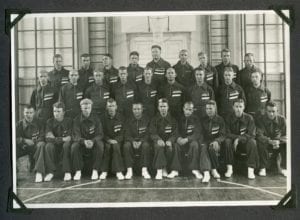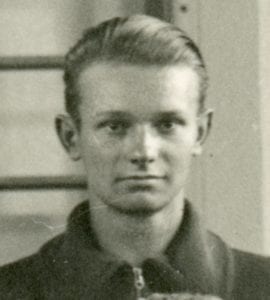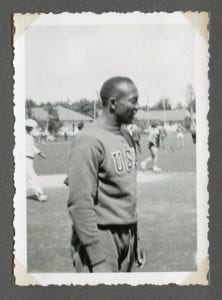My father’s photo album from 1936 Berlin Olympics prompts my reading of Richard J. Evans’s trilogy about Nazi Germany
I have long been pondering how to approach the writing of a post about my late father’s 1936 Berlin Olympics photo album.

Group portrait of athletes, from the University of Tartu in Estonia, who attended the 1936 Berlin Olympics as student observers. The photo was taken, I believe, in 1936 or earlier. Source: Kaljo Pill
The photo on the right was taken in Tartu, Estonia in 1936 or earlier. The photo, which is available online and is also featured in my father’s 1936 Berlin Olympics photo album, is of group of male university athletes from Estonia, who attended the Berlin Olympics as student observers. Students from all or most of the countries that took part in the 1936 Olympics appear to have sent groups of university-age student observers to the event.
All of the student athletes from Estonia, who attended the Games as observers, were male, so far as I know. However, the album does include photos featuring young women, who may have been Estonian and who may have had some kind of relationship to the University of Tartu athletes who attended the 1936 Berlin Games as student observers.
Also featured prominently, in my father’s photo album, is a photo of Jesse Owens, who won four gold medals at the Berlin Olympics. The album includes a Jesse Owens autograph.
When I get around to it, I will post many more photos from the 1936 album – including Berlin street scenes and photos from the Berlin Olympic Stadium.

Kaljo Pill, age about 21. Detail from 1936 group photo of young athletes from Estonia, who attended the 1936 Berlin Olympics as student observers. Source: Kaljo Pill
I have been reading extensively about the life of Jesse Owens, over the past several months, and have also been reading several books about the 1936 Summer Games.
It is of much interest for me to look closely at photos of my father from a decade prior to my birth. I did not know him then. I do know there is much information available about the history related to the times in which he grew up, and the times that prompted him and many other Estonians to leave Estonia in September 1944 as refugees.
Over the past few months, I have also been reading as much as I can about the history of the Second World War. I have read much about this topic previously, but since having a close look at my father’s 1936 photo album, I have made a point of doing a great deal more reading. In that way I can, to the best of my ability, picture those times more clearly, in my mind.
Richard J. Evans
I’ve recently been reading many books, including:
The Third Reich at War (2008) by Richard J. Evans’ and two books on strength training,
Bigger, Faster, Stronger: The Proven System for Developing Athletes (2017) by Ken Shepard and Kim Gross; and
Eat. Lift. Thrive (2017) by Sohee Lee
I’ve been reading all three of Richard J. Evans’ trilogy of books about Nazi Germany, as well as several other books addressing the same general themes. The three books in Evan’s trilogy deal with the coming to power of the Third Reich; the Nazi regime in power in the years up to 1939; and the regime at war from 1939 to 1945.
The books about strength training are of interest to me because, like my father, I have a keen interest in fitness. As a regular attendee at the Humber Fitness Centre on Lake Shore Blvd. West, I am currently working on learning to do the Squat and the Dead Lift, as I want to gain proficiency at such compound exercises. The above-noted books are helpful, in enabling me to figure out some of the details for correct performance of these two great strength-training exercises.
High Intensity Interval Training
As part of my fitness pursuits, I also engage in High Intensity Interval Training, which includes running on a treadmill at two-minute sprints going at close to my maximum running speed.
Whenever I do the HIIT training, three times a week, the level of exertion brings to mind an image, of what it would have been like for my father to be running, at his maximum capacity, in middle-distance running events as a university athlete in Estonia.
I also think, as I am running, as hard as I can, of the tremendous achievements of Jessie Owens, as a champion athlete. His going wasn’t easy, once he returned to the USA after the 1936 Olympics. Yet his achievements continue to inspire many of us, even these many years later. My own father’s achievements, as a student athlete in Estonia also inspires me, as one of the few people, who are still alive who would remember who he was, and what his life was about.
Update
A Sept. 6, 2018 CBC article is entitled: “Trudeau says Canada will formally apologize for turning away German Jews in 1939.”


It is interesting that you are commenting on Jesse Owens, one of the things I wrote about years ago. My mother’s grandfather arrived in the UK around age 29 after 20 years at sea during which he acquired his Ship’s Carpenter certificate. Both his parents, farmers in Bromarf, had died and his older sister than the house with a younger sister while the older brother and he ran the farm. Hating farm chores the only other option was to go to sea with his uncle.
The family name was Degerlund as the family had moved to Bromarf from Norr Degergard in the north century earlier before surnames so their family name came out as a place name as in “the land of Deger” which they were referred to as having come from. Locally om Bromarf a fellow would be referred to as “Gustaf from the land of Deger” which ultimately became “Gustaf from the Deger land” (in English) and subsequently in Swedish, “Gustaf Degerlund”.
Well, Gustaf Degerlund and his uncle travelled the world in the old wooden ships back in the 1860s and 70s, and London UK was often a point of departure so they learned the language of the seas which was usually a form of English. Ultimately, both of them decided eventually, a probably separately, to settle in the UK and marrying English women. The uncle eventually died in France and was buried there during WWI. I suspect it was a result of getting sick onboard his ship rather than because of the war.
Nevertheless, he was buried along with war dead in a military cemetery according to the Commonwealth War Graves Commission as he died in a military hospital at the time in France. Gustaf married the widowed daughter of the owner of a window manufacturing company that took up four shops and sold all of the necessary equipment for those wishing to do their own work as well. Ultimately, he ended up running the business. In 1925 he applied for his English citizenship as he had been there for about 35 years at that point and he would eventually retire so needed the pension income. Little did he know then that he would live to be over 90 years old at the time of his death.
Finland was in a very difficult position during WWII. It had been a Duchy of Russia for about a hundred years and in fact their top general was actually a famous general in the Russian Army. When Russia tried to take over Finland to gain total access to the sea, they were able to secure part of Finland but not all of it. Aware of Russia goal, the Finns approached the British for assistance however since the large Russia was a British allie during WWII it was a no-go situation. So the Finns decided to join the Nazis knowing that they would then provide protection for the country who wanted to take them over.
End result, it was simply a trade-off to protect their own country and not so much an desired allegiance to the Nazi party. While some faction actually went to Germany for training and fought in Europe with the Nazi Party, it was not their reason for being. To show you how a country changes a family, my late mother’s two uncles who were both her age, flew for the RAF in the war, one becoming a spitfire pilot who crashed but survived in a full body cast put on him by a German doctor where he spent the rest of 1944-45 after some 86 operational flights over Europe. He spent another year in hospital back in England and had a difficult time walking for the rest of his life.
Hence, I understand why Jaan’s father chose to leave Estonia for Canada in 1944. Under the Russian Empire headed up by the Royal Family which was overthrown in 1917 by Lenin and the Bolsheviks, not everyone agreed with communism so a number of smaller countries did not become part of the new group which ultimate formed with others as the USSR in 1922. That included both Finland and Estonia along with others like Latvia, Lithuania and Poland. For smaller countries in the shadows of looming giants, it became an ongoing problem that had to be solved somehow. Each found their own solution…Poland was invaded by the Russians and Finland joined Germany to fight them off. It took the better part of the next 50 years to finalize the end of the USSR by 1991 along with the resignation of Gorbachev the last leader of the USSR and certainly a good one compared to others before and after him from all accounts.
One last note to Jaan, take a look at Jessie Owens’ brother who also did well in his life yet was overshadowed by Jessie’s accomplishments.
Good to read the overview, Bob.